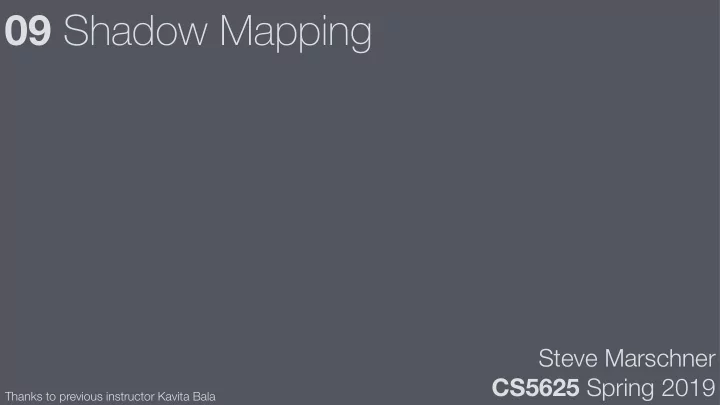

09 Shadow Mapping Steve Marschner CS5625 Spring 2019 Thanks to previous instructor Kavita Bala
Shadows as depth cue [tricks-and-illusions.com]
Shadows as anchors
Shadows as anchors
Fake shadows Before we get into more complex methods… • if a shadow is just needed to help anchor an object to a plane, very simple techniques can su ffi ce • classic: project shape of object, blur, use as mask to darken floor Shadow baking • a more principled approach • establish texture coordinates on floor • for each texel compute irradiance • perfectly accurate for di ff use receivers when the light and all geometry are static IKEA Place iOS app
Shadow maps
Shadow maps
Shadow maps Main idea: reuse the z-bu ff er mechanism to test for light source visibility • introduced by Lance Williams in 1978 • very widely used approach for point-like lights Shadow testing and visibility testing are similar problems • given a point on a surface, is it visible to an { observer | light } at a fixed location? • for visibility: interpolate screen-space (x,y,z); consider depth bu ff er value stored at screen-space (x,y); z <= bu ff er(x,y) implies visible • for shadow: compute light-space (x,y,z) of fragment; z <= bu ff er(x,y) implies illuminated Some serious di ff erences in practice • most notably: fragments do not line up with depth bu ff er samples (they are scattered irregularly in light space)
[Möller et al. RTR ]
Mark Kilgard
Mark Kilgard
Mark Kilgard
Mark Kilgard
Shadow Map Issues • if A and B are approximately equal? • Speckling slide courtesy of Kavita Bala, Cornell University
Mark Kilgard
Mark Kilgard
Mark Kilgard
opengl-tutorial.org first try at shadow mapping
Mark Kilgard not enough shadow bias good shadow bias too much shadow bias
opengl-tutorial.org shadow mapping with constant bias
opengl-tutorial.org shadow mapping with slope-dependent bias
opengl-tutorial.org closed surfaces and slope-dependent bias
opengl-tutorial.org adding percentage-closer filtering
Shadow map sample rate—bad case Light behind object Light’s “view direction” almost opposite the eye’s view direction “Dueling frusta” Mark Kilgard eye view light view
Cascaded shadow maps (aka. parallel-split SM) [Möller et al. RTR ]
Cascaded shadow maps Idea: split the view volume • cut into several slabs by depth • handle shadows in each slab with a separate shadow map • compute shadow frusta to exactly bound each piece • use fragment depth to decide which map to sample Design choices • how to split the depth range (often logarithmically) • set near distance with great care (has big e ff ect on resolution of shadows) • can be smarter about bounds: only need to bound objects, not whole view volume…
Fan Zhang, Chinese U. Hong Kong Single shadow map, 2048x2048 Four 1024x1024 shadow maps (equal memory)
Filtering shadow maps Shadow map lookups cause aliasing, need filtering As with normal maps, pixel is a nonlinear function of the shadow depth • this means applying a linear filter to the depth is wrong We want to filter the output, not the input, of the shadow test • what fraction of samples pass the test • samples pass the test if they are closer than the shadow map depth • therefore “percentage closer filtering” or PCF
Percentage Closer Filtering • Soften the shadow to decrease aliasing – Reeves, Salesin, Cook 87 – GPU Gems, Chapter 11 Kavita Bala, Computer Science, Cornell University
1 sample SM Kavita Bala, Computer Science, Cornell University
4 sample PCF Kavita Bala, Computer Science, Cornell University
16 sample PCF Kavita Bala, Computer Science, Cornell University
Kavita Bala, Computer Science, Cornell University
Soft shadows from small sources Main e ff ect is to blur shadow boundaries • PCF can do this • …but how wide to make the filter? Real shadows depend on area of light visible from surface • this can vary in complex ways • example: sun viewed through leafy trees Useful approximation: convolution • shadows are convolutions when the blocker and source are parallel and planar • occluder fusion: approximating some occluding geometry as a planar blocker
Michael Schwarz, SIGGRAPH 2013 Real Time Shadows course Hard � Shadows Umbra Completely � lit
Michael Schwarz, SIGGRAPH 2013 Real Time Shadows course Soft � Shadows Penumbra Umbra Completely � lit
Michael Schwarz, SIGGRAPH 2013 Real Time Shadows course Shadow � Hardening � on � Contact
Percentage � Closer � Soft � Shadows Michael Schwarz, SIGGRAPH 2013 Real Time Shadows course 1. Blocker � search Shadow � map Average � occluder � depth �� ��� �
Percentage � Closer � Soft � Shadows � ����� Michael Schwarz, SIGGRAPH 2013 Real Time Shadows course 1. Blocker � search 2. Penumbra � width � estimation � ��� � � � Planar � � � � ��� � � occluder � �������� � � ����� � ��� � ��������
Percentage � Closer � Soft � Shadows Michael Schwarz, SIGGRAPH 2013 Real Time Shadows course 1. Blocker � search 2. Penumbra � width � estimation � � 3. Filtering Filter � region (size � ��� �������� ) � 50% �
Percentage-closer soft shadows Fernando, NVidia whitepaper ~2005
Recommend
More recommend